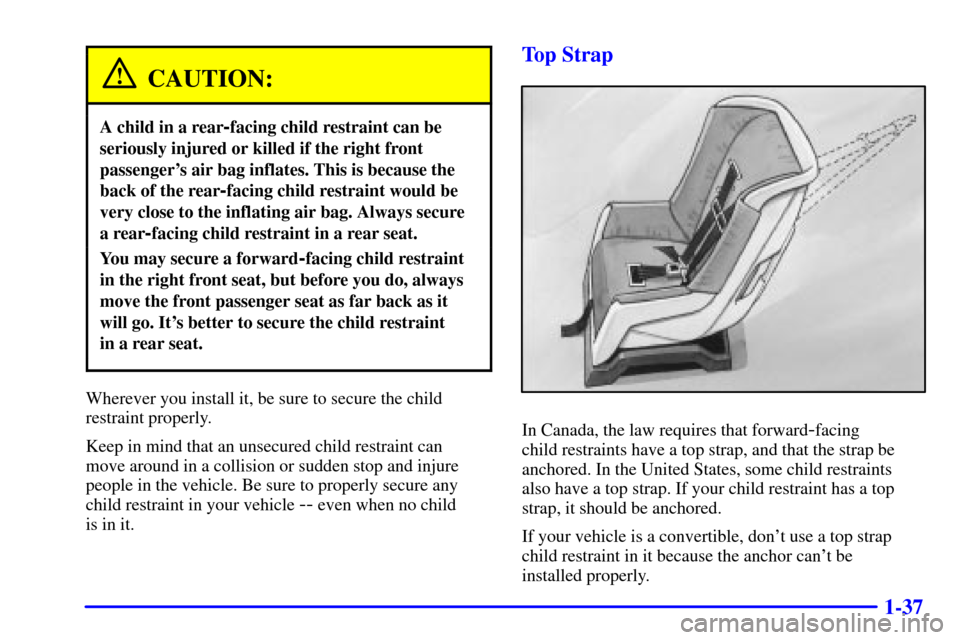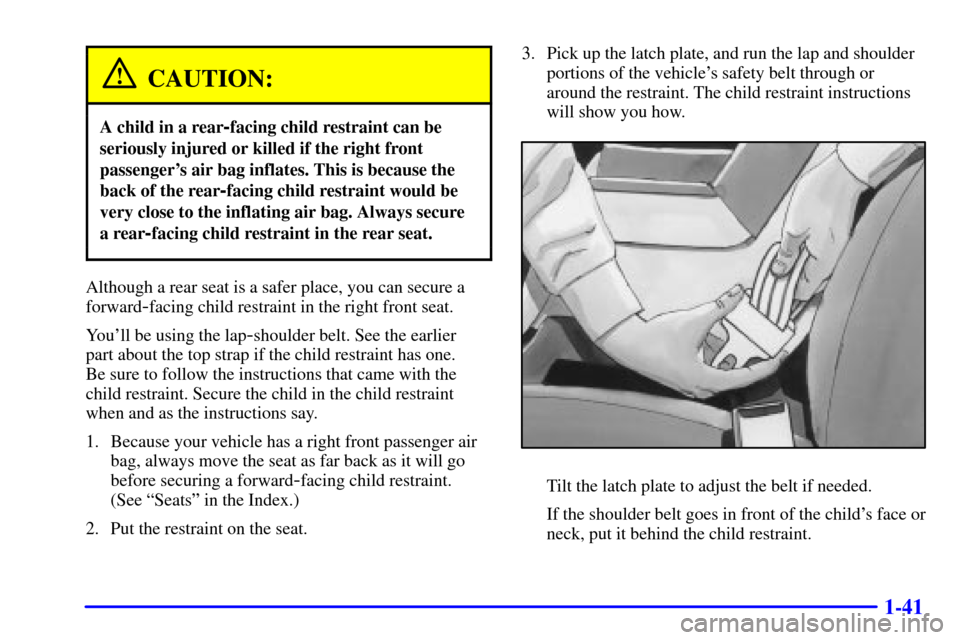Page 49 of 357

1-37
CAUTION:
A child in a rear-facing child restraint can be
seriously injured or killed if the right front
passenger's air bag inflates. This is because the
back of the rear
-facing child restraint would be
very close to the inflating air bag. Always secure
a rear
-facing child restraint in a rear seat.
You may secure a forward-facing child restraint
in the right front seat, but before you do, always
move the front passenger seat as far back as it
will go. It's better to secure the child restraint
in a rear seat.
Wherever you install it, be sure to secure the child
restraint properly.
Keep in mind that an unsecured child restraint can
move around in a collision or sudden stop and injure
people in the vehicle. Be sure to properly secure any
child restraint in your vehicle
-- even when no child
is in it.
Top Strap
In Canada, the law requires that forward-facing
child restraints have a top strap, and that the strap be
anchored. In the United States, some child restraints
also have a top strap. If your child restraint has a top
strap, it should be anchored.
If your vehicle is a convertible, don't use a top strap
child restraint in it because the anchor can't be
installed properly.
Page 50 of 357
1-38
If your vehicle is not a convertible, two top strap anchors
are already installed for the rear seating positions. You'll
find the anchors behind the rear seat, on the floor in the
cargo area.
Anchor the top strap to this bracket. Once you have the
top strap anchored, you'll be ready to secure the child
restraint itself.
Securing a Child Restraint in a Rear
Seat Position
You'll be using the lap-shoulder belt. See the earlier
part about the top strap if the child restraint has one.
Be sure to follow the instructions that came with the
child restraint. Secure the child in the child restraint
when and as the instructions say.
1. Put the restraint on the seat.
2. Pick up the latch plate, and run the lap and shoulder
portions of the vehicle's safety belt through or
around the restraint. The child restraint instructions
will show you how.
Page 52 of 357
1-40
4. To tighten the belt, pull up on the shoulder belt while
you push down on the child restraint. If you're using
a forward
-facing child restraint, you may find it
helpful to use your knee to push down on the child
restraint as you tighten the belt.
5. Push and pull the child restraint in different
directions to be sure it is secure.To remove the child restraint, just unbuckle the vehicle's
safety belt and let it go back all the way. The safety belt
will move freely again and be ready to work for an adult
or larger child passenger.
Securing a Child Restraint in the Right
Front Seat Position
Your vehicle has a right front passenger air bag. Never
put a rear
-facing child restraint in this seat. Here's why:
Page 53 of 357

1-41
CAUTION:
A child in a rear-facing child restraint can be
seriously injured or killed if the right front
passenger's air bag inflates. This is because the
back of the rear
-facing child restraint would be
very close to the inflating air bag. Always secure
a rear
-facing child restraint in the rear seat.
Although a rear seat is a safer place, you can secure a
forward
-facing child restraint in the right front seat.
You'll be using the lap
-shoulder belt. See the earlier
part about the top strap if the child restraint has one.
Be sure to follow the instructions that came with the
child restraint. Secure the child in the child restraint
when and as the instructions say.
1. Because your vehicle has a right front passenger air
bag, always move the seat as far back as it will go
before securing a forward
-facing child restraint.
(See ªSeatsº in the Index.)
2. Put the restraint on the seat.3. Pick up the latch plate, and run the lap and shoulder
portions of the vehicle's safety belt through or
around the restraint. The child restraint instructions
will show you how.Tilt the latch plate to adjust the belt if needed.
If the shoulder belt goes in front of the child's face or
neck, put it behind the child restraint.
Page 54 of 357
1-42
4. Buckle the belt. Make sure the release button is
positioned so you would be able to unbuckle the
safety belt quickly if you ever had to.5. To tighten the belt, pull up on the shoulder belt while
you push down on the child restraint. You may find it
helpful to use your knee to push down on the child
restraint as you tighten the belt.
6. Push and pull the child restraint in different
directions to be sure it is secure.
To remove the child restraint, just unbuckle the vehicle's
safety belt and let it go back all the way. The safety belt
will move freely again and be ready to work for an adult
or larger child passenger.
Page 68 of 357

2-11 Resynchronization
Resynchronization may be necessary due to the security
method used by the remote keyless entry system.
The transmitter does not send the same signal twice
to the receiver. The receiver will not respond to a signal
that has been sent previously. This prevents anyone
from recording and playing back the signal from
the transmitter.
To resynchronize the transmitter with the receiver,
do the following:
1. Stand close to the vehicle.
2. Press and hold the LOCK and UNLOCK buttons
on the transmitter at the same time for about
eight seconds.
The door locks should cycle and the interior lamps
should flash to confirm resynchronization.
If this does not happen, you may need to replace the
battery in your transmitter or match the transmitter to
your vehicle. See ªMatching Transmitter(s) to Your
Vehicleº in the Index.
Hatch
CAUTION:
It can be dangerous to drive with the hatch open
because carbon monoxide (CO) gas can come
into your vehicle. You can't see or smell CO.
It can cause unconsciousness and even death.
If you must drive with the hatch open or if
electrical wiring or other cable connections
must pass through the seal between the body
and the hatch:
�Make sure all other windows are shut.
�Turn the fan on your heating or cooling
system to its highest speed with the setting
on VENT. That will force outside air into
your vehicle. See ªComfort Controlsº in
the Index.
�If you have air outlets on or under the
instrument panel, open them all the way.
See ªEngine Exhaustº in the Index.
Page 74 of 357

2-17
PASS-Key� II
Your vehicle is equipped
with the PASS
-Key II
(Personalized Automotive
Security System)
theft
-deterrent system.
PASS
-Key II is a passive
theft
-deterrent system.
It works when you insert
or remove the key from
the ignition.
PASS
-Key II uses a resistor pellet in the ignition key
that matches a decoder in your vehicle.
When the PASS
-Key II system senses that someone is
using the wrong key, it shuts down the vehicle's starter and
fuel systems. For about three minutes, the starter won't
work and fuel won't go to the engine. If someone tries to
start your vehicle again or uses another key during this time,
the vehicle will not start. This discourages someone from
randomly trying different keys with different resistor pellets
in an attempt to make a match.
The ignition key must be clean and dry before it's
inserted in the ignition or the engine may not start.
If the engine does not start and the SECURITY light
stays on when you try to start the vehicle, the key may be
dirty or wet. Turn the ignition off.Clean and dry the key. Wait about three minutes and try
again. The SECURITY light may remain on during this
time. If the starter still won't work, and the key appears
to be clean and dry, wait about three minutes and try
another ignition key. At this time, you may also want to
check the fuses (see ªFuses and Circuit Breakersº in the
Index). If the starter won't work with the other key, your
vehicle needs service. If your vehicle does start, the first
ignition key may be faulty. See your dealer or a
locksmith who can service the PASS
-Key II.
If you accidentally use a key that has a damaged or
missing resistor pellet, the starter won't work. The
SECURITY light will flash. But you don't have to
wait three minutes before trying another ignition key.
See your dealer or a locksmith who can service the
PASS
-Key II to have a new key made.
If you're ever driving and the SECURITY light comes on
and stays on, you will be able to restart your engine if you
turn it off. Your PASS
-Key II system, however, is not
working properly and must be serviced by your dealer.
Your vehicle is not protected by the PASS
-Key II system.
If you lose or damage a PASS
-Key II ignition key, see
your dealer or a locksmith who can service PASS
-Key II to
have a new key made. In an emergency, call the Chevrolet
Roadside Assistance Center at 1
-800-CHEV-USA� or
1
-800-243-8872 (In Canada call 1-800-268-6800).
Page 113 of 357

2-56 Delayed Illumination
With delayed illumination, the courtesy lamps will
come on and stay on for 25 seconds after you enter
the vehicle and close the door. They will also stay on
for five seconds after you exit the vehicle and close the
doors. Delayed illumination will be shortened if the
ignition is turned to RUN or if the power locks are
activated. To turn this feature on or off, see ªFeature
Customizationº in the Index.
Exit Lighting
With exit lighting, the interior lamps will come on when
you remove the key from the ignition to help you see
while exiting the vehicle. To turn this feature on or off,
see ªFeature Customizationº in the Index.
Front Map Lamps
Your inside rearview mirror includes two map lamps.
Each lamp has its own switch. Use the switch closest to
the lamp to turn it on. The lamps will also come on
when a door is opened.
Retained Accessory Power (RAP)
Your vehicle is equipped with a Retained Accessory
Power (RAP). It allows certain features on your vehicle
to continue to work up to 10 minutes after the ignition
key is turned to OFF.
Your convertible top, power windows, power mirrors
and audio system will work when the ignition key is in
RUN or ACC. Once the key is turned from RUN to
OFF, these features will continue to work for up to
10 minutes or until either door is opened.
Your power door unlock and remote hatch release
features will work when the ignition key is in RUN or
ACC, or if either door is open. Once the key is turned
to OFF, these features will continue to work for up to
10 minutes. If either door is open and the ignition key
is off, these features will continue to work until both
doors have been closed for about 30 seconds or until
the theft
-deterrent system arms. At that time, both the
power door unlock and remote hatch release features
will be disabled to enhance the security of the vehicle.
The power door lock function will work at all times
except when lockout prevention is enabled. See
ªLockout Preventionº in the Index.